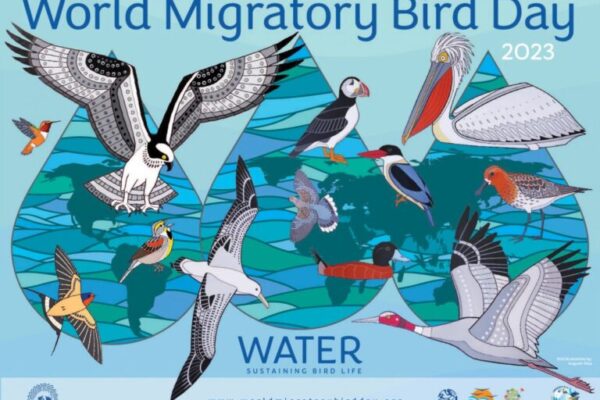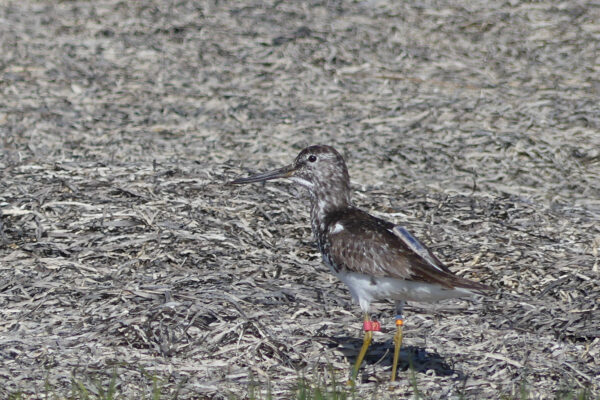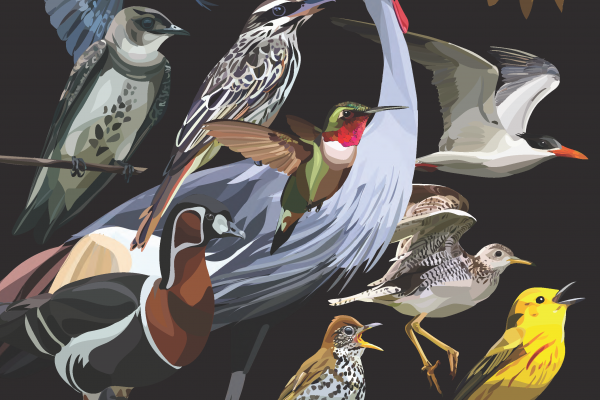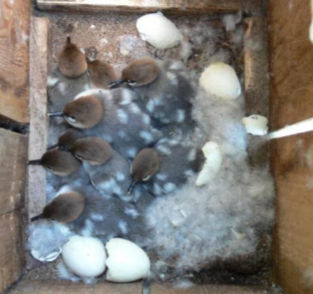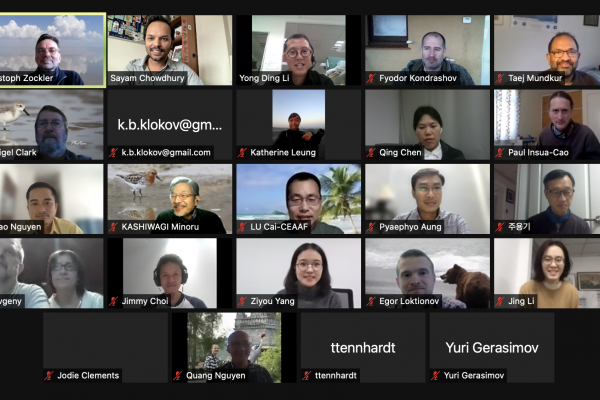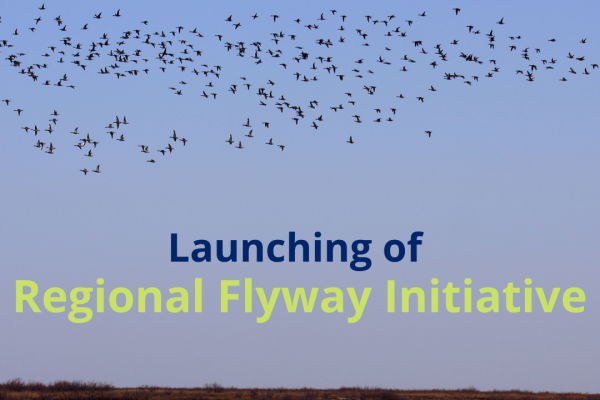-
World Migratory Bird Day 2023 highlights impact of the growing water crisis on migratory birds
BOULDER/BONN/INCHEON, 13 May 2023 – Water and its importance to migratory birds – and the increasing threats to both water quality and quantity - is the focus of this year’s World Migratory Bird Day, a global campaign that aims to raise awareness of migratory birds and the need for international cooperation to conserve them. Activities to mark the campaign will be held globally on two peak days in May and October under the theme “Water: Sustaining Bird Life” Water is fundamental to sustaining life on our planet. Migratory birds rely on water and its associated habitats—lakes, rivers, streams, ponds, swamps, marshes, and coastal wetlands—for breeding, resting, refueling during migration, and wintering. Yet increasing human demand for water, along with climate change, pollution, and other factors, are threatening these precious aquatic ecosystems. Headlines around the world are sounding alarm: 35 percent of the world’s wetlands, critical to migratory birds, have been lost in the last 50 years. Utah’s Great Salt Lake, the largest saltwater lake in the Western Hemisphere and used by more than a million shorebirds, is in danger of disappearing within five years. Across the Amur-Heilong Basin in Asia, climate change is amplifying the impact of habitat destruction by depleting natural water systems and depriving migratory birds of vital breeding and stopover site. These sobering examples go hand-in-hand with recent reports that reveal that 48 percent of bird species worldwide are undergoing population declines. Another poignant example is that of the Aral Sea shared by Kazakhstan and Uzbekistan. Once the fourth-largest lake in the world, it is widely regarded as one of the planet’s worst water-related environmental disasters. Soviet-era irrigation projects almost completely dried up the lake, which led to the loss of livelihoods for fishermen and farmers and the deterioration of public health due to toxic dust and reduced access to clean water. The impact has been severe for the communities around the lake, but also for migratory birds, which lost important food sources and a critically important stopover point on their journey. Another example is the Sahel, a vast semi-arid region in Africa: Prolonged periods of drought, deforestation, and overgrazing in the Sahel have led to the degradation of the soil and loss of vegetation, threatening the survival of both the local human population and wildlife, including migratory birds. Lake Chad, one of the largest water bodies in Africa in 1960, lost 90 % of its area, depleting water resources for local communities and also for many migratory birds. World Migratory Bird Day serves as an international call to action for the protection of migratory birds, whose ranges often span multiple countries, and are facing many different threats worldwide. The annual campaign is organized by the Convention on the Conservation of Migratory Species of Wild Animals (CMS), the African-Eurasian Migratory Waterbird Agreement (AEWA), Environment for the Americas (EFTA), and the East Asian-Australasian Flyway Partnership (EAAFP). World Migratory Bird Day 2023 will be officially held on 13 May and 14 October. The two days of World Migratory Bird Day reflect the cyclical nature of bird migration as well as the fact that there are varying peak migration periods in the northern and southern hemispheres. Events to raise awareness of migratory birds and the importance of water will take place all over the world including in local parks, nature centers, museums, libraries, schools, and other locations on these peak days and throughout the year. To learn more about this year’s World Migratory Bird Day campaign and actions to take, visit www.worldmigratorybirdday.org and EAAFP WMBD 2023 webpage: https://www.eaaflyway.net/world-migratory-bird-day-2023/ Also, please have a look of the Campaign Strategy for promoting World Migratory Bird Day, click [here]. For more resources, visit the Trello Board [here]. Message from the Partners of World Migratory Bird Day Convention on Migratory Species (CMS) “Water is essential for people as well as for migratory birds and other wild species of animals. Yet around the world, the availability and quality of water is under enormous pressure, with deeply concerning implications. The looming global water crisis requires urgent action by governments, businesses, local communities as well as individuals. Because migratory birds cross national borders and even continents, international cooperation is essential to ensure that actions are taken to conserve and restore important habitat for migratory birds, and to address the drivers of water loss, pollution, and climate change,” said Amy Fraenkel, Executive Secretary of the Convention on the Conservation of Migratory Species of Wild Animals (CMS). African-Eurasian Migratory Waterbird Agreement (AEWA) “The water crisis recently highlighted by the UN 2023 Water Conference also has a tremendous impact on migratory birds. In the Sahel in particular, many wetlands on which migratory waterbirds rely during the non-breeding period are shrinking. Water is a vital resource for all, local communities as well as birds. By reducing our consumption, combatting climate change, and managing wetlands wiser, we can improve the situation,” said Dr. Jacques Trouvilliez, Executive Secretary of the Agreement on the Conservation of African-Eurasian Migratory Waterbirds (AEWA). Environment for the Americas (EFTA) “World Migratory Bird Day 2023 spotlights the vital role that water plays in the survival of our shared birds. The focal species illustrated on the campaign poster depict the intricate bond each bird shares with water. The diminutive Rufous Hummingbird thrives on nectar-producing flowers that rely on water for their blooms, and the Dickcissel scours the grasslands for seeds that hold the moisture they need. White Pelicans and Ospreys seek their prey in freshwater lakes, while the magnificent Wandering Albatross and Atlantic Puffin remain at sea. WMBD is an opportunity to unify our voices for the conservation of migratory birds and to celebrate their spectacular journeys,” said Dr. Susan Bonfield, Executive Director at Environment for the Americas (EFTA). East Asian-Australasian Flyway Partnership (EAAFP) “This year's WMBD theme serves as a vital reminder of the linkage of migratory birds to the importance of protecting aquatic ecosystems and conserving wetlands. As birds such as threatened Spoon-billed Sandpiper, Dalmatian Pelican, and Sarus Crane migrate, they rely heavily on wetlands for survival. We must take urgent actions and collaborate at all levels, from citizens to among governments, to tackle the problems of saving water and aquatic ecosystem, and ensure that migratory birds continue to thrive.” Ms. Yeounhee Ahn, Deputy Executive of East Asian-Australasian Flyway Partnership (EAAFP).
Continue reading -
Summary of interim results of Shorebird Hunting Impact Assessment Project: northern part of EAAF in North-East of Russia (2019-2021)
EAAFP Small Grant Fund project by Konstantin B. Klokov, Saint-Petersburg State University & Peter the Great Museum of Anthropology and Ethnography (Kunstkamera) RAS; Aleksandr I.Matsyna, Working Group on Shorebirds of Northern Eurasia The first approach to assessment of hunting pressure on shorebirds in selected areas of the Kamchatka Peninsula, with special focus on the Far-Eastern Curlew. Moscow – Petropavlovsk-Kamchatsky, 2019. By Konstantin B. Klokov, Yuri N. Gerasimov, Kamchatka Branch of Pacific Institute of Geography FED RAS/BirdsRussia Kamchatka Branch, Evgeny Syroechkovskiy Ministry of Natural Resources and Environment of Russian Federation/Birds Russia, Russia, with contribution from: Sergey Kharitonov, Russian Bird Ringing Centre IPEE RAN Rus Acad Sci., Anton Ivanov, Working Group on Shorebirds on Northern Eurasia, Dmitriy Dorofeev, All-Russian Research Institute for Nature Conservation. The assessment of hunting pressure on shorebirds in Sakhalin Island, with special focus on the Far-Eastern Moscow - Nizhniy Novgorod – Yuzhno-Sakhalinsk, 2020. By Aleksandr I.Matsyna, Working Group on Shorebirds of Northern Eurasia, Matsyna Ekaterina L., Working Group on Shorebirds of Northern Eurasia, Konstantin B. Klokov, Evgeny E. Syroechkovskiy, with contribution from: Sergey Kharitonov, Zoia V.Reviakina, Working Group on Shorebirds of Northern Eurasia, Vladimir B. Zykov, Working Group on Shorebirds of Northern Eurasia. Evaluation of hunting pressure of shorebirds in the Russian Far East with special attention to Numenius (Curlews, Whimbrels) and other threatened species - Stage III: surveys in Khabarovskiy Krai and Amur oblast’. Moscow - Nizhniy Novgorod - Khabarovsk – Blagoveshchensk, 2021. By Aleksandr Matsyna, Vladimir Pronkevich, Institute of Water and Ecology Problems, Ekaterina L. Matsyna, Anton A. Sasin, Blagoveshchensk, Konstantin Klokov, Evgeny E. Syroechkovskiy, with contribution from Sergey Kharitonov. INTRODUCTION Conservation of Arctic migratory bird is based on holistic approach, which treated together all species' habitats within its annual life cycle. Arctic-breeding migratory birds are a significant component of both Arctic culture and ecosystem health. Many of them require special attention of researchers as they are among the rare and endangered species or the game resources. The protection of Arctic migratory birds, as well as the issues of sustainable use of their resources (concerning game species) are complicated because Arctic-breeding birds use different flyways to move from Arctic breeding grounds to overwintering or stopover sites at lower latitudes. Migration routes from breeding areas in the eastern part of Russian Arctic to overwintering and stopover sites follow mainly the western coast of the Pacific Ocean and cross 22 Asian countries. The sum of these routes is defined as the East Asian-Australasian Flyway (EAAF). The EAAF is the most species-rich of the world’s nine major flyways. In addition, the EAAF has the highest proportion of declining at an unprecedented rate waterbird populations, especially shorebirds. Of the 63 populations of 52 migratory species of shorebirds migrating this way, 20 populations of 17 species may become extinct or approach extinction in the near future if no measures are taken [1, 2, 3]. Over the past 30 years, this problem has attracted the attention of many ornithologists and conservationists. The main reason for the decline in EAAF shorebirds populations is the reduction of the main habitats: coastal and inland wetlands [4, 5]. Hunting is also perceived as a medium-or high-level threat, but it is difficult to assess its scale due to poor knowledge of the issue [6, 7]. The Arctic Migratory Bird Initiative (AMBI) was started by CAFF in 2015, and aims to improve the conservation status and secure the long-term sustainability of declining of Arctic-breeding migratory birds through flyway-level cooperation with Arctic and non-Arctic countries and partners. AMBI is working across four major flyways to engage global partners on the issue of bird and habitat conservation, including the mitigation of harmful anthropogenic actions and hunting. AMBI Work Plan objective 3 states to prevent illegal hunting and regulate unsustainable legal harvest of Arctic migratory birds along the EAAF, with a focus on Spoon-billed Sandpiper (SBS), Lesser White-fronted Goose, Bar-tailed Godwit, and other priority species. Action 3.1 initiates surveys of hunting pressure on Arctic-breeding shorebirds in stopover areas in the North-East of Russia, including Chukotka, Kamchatka, Sakhalin and mainland coasts of Sea of Okhotsk [8]. Implementation of these activities was started in 2019 by BirdsRussia in cooperation with Working Group on Waders on Northern Eurasia. It is the first project focused on the assessment of hunting pressure on Arctic shorebirds in Russia. The main aim is to reveal the territories of the largest hunting bag of shorebirds and specify the dates (season) of hunting there first of all for priority East Asia-Australasia Flyway Partnership species of shorebirds (waders): Curlew Sandpiper, Red Knot (Calidris canutus), Great Knot (Calidris tenuirostris), Far Eastern Curlew (Numenius madagascariensis), Black-tailed Godwit and Spoon-billed Sandpiper (Eurynorhynchus pygmeus). Special attention is paid to Whimbrel (Numenius phaeopus), which is the most popular shorebird target species for legal hunting in the Russian Far East as well as to the most important endangered species: Far Eastern Curlew, Godwit, SBS, etc 1.PROJECT GOAL AND OBJECTIVES The main goal of the project is to assess shorebird hunting pressure in the northern part of the EAAF in the north-east of Russia. The project is focused on shorebird species prioritised by the EAAFP. Special attention was focused on Far Eastern Curlew, Whimbrel and SBS. Whimbrel is a popular species for legal hunting in the Far East of Russia and hunting has a significant impact on the number of this species. Far Eastern Curlew is included in the list of globally threatened species (IUCN Red List) and is critically endangered in Australia. In Russia it is a protected species, included in the Red Data book. Nevertheless, hunters quite frequently harvest Far Eastern Curlew together with Whimbrel due to misidentification and often do it on purpose as for many hunters it is the most wanted game among all the shorebird species because of its large size. Both species are understudied and when the opportunity presents itself we fill the knowledge gaps about them, their conservation and use. SBS is a critically endangered species, one of the rarest shorebirds in Russia and in the world. An important goal of the project is to identify modern and historic population trends of different species and ecological groups of shorebirds under hunting pressure (both legal and illegal bird harvest) as well as other factors. Thus, the following objectives had to be attained: Identify main shorebird staging sites during migration where they are subject to intensive hunting Compare the timing of hunting seasons with the timing of migration and stop- overs of different shorebird species, identify the most vulnerable Estimate the number of shorebird hunters in different areas of the Russian Far East, including hunters on large-sized, medium-sized and small-sized Inspect model settlements (villages and small towns), including interviews, anonymous questionnaires and direct observation of hunting processes within the project time- Assess the feasibility and attempt to organize online anonymous Give an estimate of an average number of shorebirds harvested by one hunter in different regions of the Russian Far Calculate an estimate of shorebird harvest in different regions of the Russian Far using expert assessment and, where possible, extrapolation, in particular to give an approximate estimate for large and small-sized shorebird harvest and for the most important species, if A separate task is to develop and refine the research methods of assessing the hunting pressure on shorebirds in the Far This is a pioneer line of research started practically from scratch. Methods are improved every year. 2.METHODOLOGY The methodology is based on the waterfowl hunting estimation experience in the eastern part of Russian Arctic. It was developed by E.E. Syroechkovsky and K.B. Klokov and used in 1999–2006 to make an estimation of bird harvest in 22 villages of Chukotka and northern Yakutia located near the sea coast [9]. We slightly changed this method in connection to the fact that, unlike waterfowl, shorebirds are not the main object of hunting. According to our methodology the survey of each village includes two steps. First, an in-depth interview with 2–3 experts takes place to identify at a qualitative level the general picture of the way how shorebird hunting occurs at this place and how important it is for local hunters. As a result of the interview we learned about the bigger picture of shorebird hunting in the village. The second step was the survey using anonymous questionnaires, which were filled by hunters themselves. The questionnaire was made as short as possible because each extra question increases the possibility that the hunter would think the questionnaire is too complicated and would not want to waste time completing it. The main part of hunters does not distinguish species of shorebirds. Therefore, in anonymous questionnaires, we mostly do not use names of shorebird species, but ask hunters to divide the harvested shorebirds into the following groups: Whimbrel, which is very popular and well known to Russian Far East hunters, other big-sized shorebirds except Whimbrel, medium-sized shorebirds, small-sized In addition, we asked to list the species of harvested shorebirds, if the hunter knows them, but only a few of respondents did this. Sampling. Since it was not possible to create a random sample, we used two methods: Asked hunters to fill out a questionnaire at the time when they visited the office of the hunting society in order to return a seasonal hunting permit. This method was mainly used the help of employees of the hunting societies. However, it was not possible to use it in all The Snowball Method, when each hunter, filling out a questionnaire, gave the contact details of one or more other hunters. This method gives good results in small Apart from the survey of hunters in settlements, we conducted a direct observation of the hunting process with visual inspection of the hunters' harvest at the model plots. This allowed to identify species and species ratio of shorebirds and other birds harvested there. The advantage of the direct observations of hunters at the model plots was the possibility to observe the hunting process, conduct a significantly higher number of informal interviews with hunters and visually inspect their harvest, which allowed to identify species of harvested shorebirds, which hunters themselves did not know. 3.SURVEYED REGIONS Survey on the impact of various aspects of hunting on the population and numbers of shorebirds in the Russian Far East has been carried out for three years. During this period four regions have been surveyed (fig. 1). Figure 1: Regions of the Russian Far East surveyed in 2019-2021 as part of the Shorebird Hunting Impact Assessment Project: 4 - Amur Oblast, 5 - Khabarovsk Krai, 7 - Sakhalin Oblast, 10 - Kamchatka Krai Regions proposed for survey in the nearest years: 8 - Magadan Oblast, 6 - Primorskiy Krai, 1 - Republic of Buryatia and 2 - Zabaykalskiy Krai; Regions for prospective studies: 3 - Republic of Sakha (Yakutia), 9 - Chukotka Autonomous Okrug. Kamchatka. Here, in 2019, the methodology of material collection was tested and perfected. It was based on anonymous questionnaires. The questionnaires were distributed through the hunting organization service. A total of 400 questionnaires were collected. For the first time, the number of harvested shorebirds of two size groups, large/medium and small species, was estimated for this region (Table 1). Table 1. Estimation of number of harvested shorebirds in Kamchatka in 2019 Sakhalin Oblast, survey 2020. Sakhalin Island is one of the most populated and developed regions of the Russian Far East and a very important migration area for many shorebird species. There are many hunters here and many places with high concentrations of shorebirds. On Sakhalin we have conducted many interviews and informal discussions with hunters. This allowed us to determine the level of harvesting of different shorebird species more accurately (Table 2). Total amount of shorebird harvested on Sakhalin was even higher than on Kamchatka! Particularly alarming was an unexpectedly high level of harvesting of Far Eastern Curlew. While in Kamchatka hunters shot it mainly due to ignorance and confusion with Whimbrel, on Sakhalin this species is a prestigious trophy for many hunters. Table 2. Expert assessment of yearly harvest of shorebirds in the Sakhalin oblast based on the survey results * - number of harvested birds varies depending on the Whimbrel population number fluctuation from year to year ** - harvest is underestimated as survey data does not fully reflect the shorebird harvest in several districts of Sakhalin island Khabarovsk Krai, survey 2021. Hunting here has a large impact on shorebirds in the areas adjacent to the Sea of Okhotsk. Species such as Great Knot, Red Knot, Bar-tailed Godwit, and others are regularly and in considerable numbers shot there. We also recorded incidental harvesting of the SBS in Okhotsk. Hunters do not distinguish between species of shorebirds and usually shoot in flocks. The Far Eastern Curlew is less harvested here than on Sakhalin. Hunters shot it mainly in central part of Khabarovsk Krai and in the valley of Amur River (Table 3). Table 3. Estimation of number of yearly harvested shorebirds in Khabarovsk Krai Amur Oblast, survey 2021. Shorebird hunting is less developed here, as there are no large migratory concentrations of shorebirds. Nevertheless, the Far Eastern Curlew is threatened here as well. This species is most often hunted either in spring, during duck hunting, either by poachers. Table 4. Estimation of number of yearly harvested shorebirds in Amur Oblast Our project enabled us to obtain, for the first time, information on the scale of shorebird hunting in the Russian Far East. This is their great value. For a number of areas, such as the coast of the Sea of Okhotsk in Khabarovsk Krai and the coast of Western Sakhalin, additional research is needed as our level of knowledge about these areas remains insufficient. We envisage, if circumstances permit, to continue surveys in the remaining regions of the Far East: the Magadan Oblast (survey has been planned for autumn 2022), Primorskiy Krai and also Yakutia. 1.SPECIES AND GROUP OF SPECIES Let us consider briefly the results of the project in Kamchatka, Sakhalin, Khabarovsk Territory and Amur Oblast for selected shorebird species and groups of species. Far Eastern Curlew As the interviews show, hunters while hunting the Whimbrel often do shoot large shorebirds, including Far Eastern Curlews, Bar-tailed and Black-tailed Godwits. Some hunters do not know the right name of the species, though many of them are aware of them. Here we should distinguish between “proper poaching”, when hunters do it on purpose – they shoot all large shorebirds that have come close to them (the case common for some districts in Sakhalin Island), and "accidental poaching", when hunters shoot Far Eastern Curlews by mistake. The main reason for the error is the fact that young Curlews have a shorter bill than adult ones (similar to the Whimbrel’s bill), and hunters confuse these two species. The total number of harvested Far Eastern Curlew in all surveyed regions of the Far East, according to our estimates, may amount to more than 2 000 birds per year (table 5). In Kamchatka and partly on Sakhalin, hunters shoot it mostly occasionally when hunting Whimbrel during their southward migration. In Khabarovsk Krai and Amur Oblast, it is harvested mainly in spring, in breeding grounds (fig. 2). Table 5. Estimation of number of yearly harvested Far Eastern Curlew (Numenius madagascariensis) in different region of Russian Far East Figure 2. Areas of the highest probability of shooting on Far Eastern Curlew during the breeding and migration periods (highlighted by shading) Whimbrel As our calculations showed, the total number of Whimbrels shot in Kamchatka is about 37,000 per year. This is a very large number compared to published estimates [1, 2], where the total EAAF population of the Whimbrel is supposed to be about 55,000 birds. Considering that Whimbrels besides Kamchatka are also harvested in other regions, our results suggest that the flyway population estimate of 55,000 birds for Whimbrel is significantly lower than in reality. Published observations of Whimbrel concentrations in the several staging places [10, 11, 12, 13] and our long-term observations [14, 15] in Kamchatka also confirm this. We believe that hunters of Kamchatka and Sakhakin are making the greatest impact on the Whimbrel population on the flyway. In addition, our work has confirmed the disproportionate hunting pressure on the northern population of Whimbrel migrating via Sakhalin. In contrast to Kamchatka, where numbers of the species remain stable, significant fluctuations in abundance have been observed on Sakhalin. This indicates a perennial depression of the species in the region as a result of disproportionate hunting pressure. This is particularly dangerous when combined with the major transformation of these birds' natural habitats by oil and gas developments in northern Sakhalin. But need to survey all other parts of the flyway to verify these conclusions. Small and medium-sized shorebirds Small- and medium-sized shorebirds are not actually object of purposeful hunting. Many of them are not game species in Russia, which are not supposed to be shot. According to informal interviews, hunters shoot them not so often. Small and medium-sized shorebirds are mainly harvested: by children and teenagers, who do not have an official right to hunt but whose parents want to train them as hunters; in the absence of other game, in order not to return home empty-handed; by some gourmet hunters who love cooking and eating small shorebird soup considered a Reporting on the number of harvested small shorebirds in the anonymous questionnaires, hunters never identify species. As the interviews showed, hunters save cartridges and usually harvest small and medium-sized shorebirds by shooting dense flocks, often consisting of several species, often including rare ones. Such hunting results in a big number of wounded birds that die later and a significant number of killed birds that remain unrecovered. The total mortality of birds is likely 2-3 times higher than the number of birds used by hunters. So, the number of shot small shorebirds may be assessed as nearly two- fold as compared with the data from the questionnaires. Thus, in Kamchatka, according to the anonymous questionnaires in 2019, 14.3 % of hunters shot small-sized shorebirds. The average bag in all Kamchatka was 2.2 birds a year for one hunter. The total number of harvested birds calculated by extrapolation was more than 6000. More than half of the birds were harvested in western districts (Sobolevsky and Tigil’sky districts), where the average hunters bag per year is 10 small shorebirds. In the other regions it was less than 2 birds per year. In Sakhalin small shorebirds have a special place in the hunting practice. They are regularly harvested, either incidentally, as a rule when there is no other game, either intentionally. There are firmly fixed collective terms for this groups of birds – "galushki" or "pelmeni" in the local lingo. They are traditionally used for cooking shurpa, a thick broth with fowl and vegetables. As a rule, there is at least one enthusiast in each group of hunters, who can always harvest and cook this birds. During our survey different examples of easy and fruitful hunting were given: "60 birds with one cartridge", "a basin with two cartridges", "a dozen with one shot" and others. Even with the adjustment for a known tendency to exaggerate the result, this information is unfortunately proved by our observations. For example, on August 30 2020, 12 Dunlins were harvested with one shot by a hunter who was barely 10 years old. In September at the Odoptu bay (Northern Sakhalin) we observed two hunters who fired 5 shots on dense flocks of small shorebirds in 15 minutes and left, collecting a whole bag of game. Inspecting this territory half an hour later, we found 6 other shot Dunlins, among which were wounded birds hiding in the grass. Incidental harvest of small and medium-sized shorebirds as a rule is not a memorable experience for hunters and that is why many of them give a negative answer when the question about the harvest of these birds is first asked. Therefore, remotely completed questionnaires often provide underestimated data. But during a conversation, when they are asked clarifying questions, almost all the hunters remember doing it incidentally, in passing, and only cases of a massive harvest are imprinted in memory with figures of speech, such as "half a bucket in one go". In a number of cases we were informed that these birds may not be used for food but are thrown away if hunters take more desirable game. Spoon-billed Sandpiper Spoon-billed Sandpiper currently remains one of the most endangered bird species in the world. It has a narrow nesting range in the coastal tundras of the Chukotka peninsula. IUCN international conservation status of this species is "Critically Endangered". Sakhalin plays an important role for migratory stopovers of this species. SBS was registered here by many researchers during spring and autumn migration. Unfortunately, main SBS sighting sites in Sakhalin fully coincide with the sites of active shorebird hunting. To harvest shorebirds, hunters most often shoot dense flying flocks consisting of several species, in which SBSs usually move as well. Thus, they can become victim of any such shot. Clearly, taking into account low population of SBS in total, we are far from knowing all its traditional staging sites. It is a cause for concern that during autumn migration coinciding with autumn hunting season, SBS's sightings on the shores of Sakhalin are most dispersive and the birds could potentially end up in any place where they will be shot. In our 2020 research we did not have an opportunity to look further into this topic but now we know of many districts where there is hunting pressure in the known SBS staging sites. Monitoring and special research should be conducted in several districts of Sakhalin, important for the declining population of SBS. Seasonal protection should be introduced in a number of such sites so that there is no hunting there. We know about the shot of SBS in all of the study areas along the Sea of Okhotsk - Kamchatka, Sakhalin, and Khabarovsk (fig. 3). All known cases were incidental. The birds were killed in flocks of small shorebirds. This hunt is most common not only in northern Sakhalin, but also in several districts of Khabarovsk Krai, namely Nikolayevsky, Tuguro-Chumikansky, and Okhotsk districts. The probability of shooting of SBS in the northern part of western Kamchatka coast is supported by the fact that signal transmission from three of the nine birds with radio transmitters stopped sending signal from this area [10]. The only way to influence the local population in all these areas is to carry out long-term work to educate hunters, convincing them not to shoot indiscriminately at flocks of birds. Our project has been successful in doing this, but it needs to be continued on a much larger scale. Figure 3. Areas of the highest probability of shooting on SBS during seasonal migrations (highlighted by red points) 5.CONCLUSIONS AND RECOMMENDATIONS Arctic breeding migratory birds are in significant declines in several regions, and due to the flyway- level movement of migratory birds, a large flyway-level conservation approach is needed to improve their population status. Our study of Arctic-nesting shorebirds hunting is the first significant research in this direction. It allowed to get the first idea of shorebirds hunting in Kamchatka, Sakhalin, Khabarovsk and Amur areas. To obtain a complete picture along the northern end of EAAF, it is necessary to conduct similar studies in all other regions of the Russian Far East and Russian Arctic. As well, hunting assessment and monitoring in the four regions already surveyed should be continued in order to be able to monitor the hunting process and to get more detailed data. The results of our survey clearly showed that hunting of shorebirds in the North-East of Russia (most northern part of EAAF) may negatively impact Arctic shorebird populations especially threatened species. Hunting of protected shorebirds is often the reason of low level of awareness of hunters and lack ability to distinguish between shorebird species. Awareness raising and education must be improved. Hunting for small-sized shorebirds in North-East of Russia has declined significantly over the past 40 years, however it still remains an additional threat to the conservation of the rare protected species, including SBS. Although our study filled a significant gap, the available data on shorebirds hunting in the Russian North-East is still completely insufficient to propose and justify an effective Arctic shorebird conservation program. The methodology used by us gave acceptable results. It can be used in other regions of the Russian Far East and Arctic. However, for a quantitative assessment of the harvesting of rare species it should be supplemented with other methods. Hunting control in the all North-East of Russia, is weak. For shorebird conservation special education activities are much needed not only for hunters but as well for wildlife officers. Since hunters often shoot protected shorebirds because of their inability to identify species and lack of knowledge on the protection status. As well, hunting inspectors cannot control this process because they also can’t identify many species of birds. These activities can be conducted together with hunter societies and regional hunting agency. As we learned during our research, hunting societies are open to such activities. But they have limited resources. Significant part of hunters are really interesting to know species which they are harvesting. But there is no place where they can learn. The publication of a field guide of shorebirds of the Russian Far East is really very important for improving the level of knowledge of hunters and hunting officers. Effective conservation of shorebirds requires significantly more data on hunting bag. First of all, we need full information on all regions of Russian Far East in order to get a complete picture along the entire flyway. Secondly, it is necessary to move from a single survey to monitoring of the harvest year by year. 6.PERSPECTIVES FOR FURTHER RESEARCH Our research showed that hunting in the Far East of Russia is probably a more significant factor in the population decline of several shorebird species along the EAAF than it was previously believed. That is why international collaboration to assess hunting pressure should be continued, including activities under EAAFP, partnership with AMBI-CAFF and interactions with bilateral conventions. Based on the full inventory of knowledge about hunting in all the regions of the Russian Far East, it is necessary to conduct further research, organise monitoring and implement conservation programs. We need consider perspectives for further research, first of all, in four new regions. Magadan Oblast. This is an active waterfowl and shorebird hunting area. We expect to conduct detailed surveys here in autumn 2022, and obtain information which will help better understand the scale of harvesting of small-sized shorebirds in this area and the probability of SBS loses, as well as the situation with the catastrophic decline of the Whimbrel on Sakhalin. Primorsky Krai. The south of Primorskiy Krai, including the Lowland around the Khanka lake, is an important region for shorebirds. During migrations, many rare species stop here, including Far Eastern Curlew, Spotted Greenshank (Tringa guttifer), SBS and others. Assessment of the impact of hunting on these species is very important. These two regions should be surveyed first. Figure 4 shows the main flyways of Dunlin. The same flyways are followed by most of the other shorebirds (especially small ones) in the Sea of Okhotsk area. On this map (fig. 4) we can see that Magadan Oblast and Primorsky Krais are located along these flyways. This is also confirmed by the map presented in our report for 2019 (fig. 5), based on data from the Russian Ringing Centre and other sources. The map shows human settlements and main areas of shorebirds hunting located only on the sea coast. Figure 4. Main northward (A) and southward (B) flyways of Dunlins in the Sea of Okhotsk region [11]In the future, it would be advisable to extend the observation area and survey three inland regions as well: Zabaikalskiy Krai and Republic of Buryatia (Transbaikalia). This is an important migratory area with rather large and long stopovers of shorebirds on inland water bodies. There is no evaluation of hunting pressure on shorebirds in this regions. Yakutia. Sakha (Yakutia) Republic is the largest administrative region of Russia. Both amateur and commercial hunting is developed here. According to data of Russian Ringer Center there are many shorebird rings recovery from this region. Despite its huge surface there are road and river transport network, which will allow to organize visits to o necessary districts with shorebird hunting activities. Besides new regions, the continuation of research in several districts on the coast of Sea of Okhotsk in the Khabarovsk Krai as well as in several districts on Sakhalin Island (Ohinsky and Aleksandrovsk-Sakhalinsky districts are highly desirable. The coast of the Sea of Okhotsk is one of the least ornithologically investigated areas of the mainland coast, where important shorebird concentration sites during autumn migration are concentrated and hunting pressure is high. Figure 5. Human settlements located at the seacoast of the Russian Far East and main areas of shorebirds hunting identified from data of rings recoveries of Russian ringer centre, published sources and unpublished knowledge of Russian ornithologists South-western coast of Sakhalin is important area for the nesting and migration of shorebirds but very poorly studied. The most important of its bays (Tyk, Viakhtu, the Lakh river estuary) are lacking data on the number and species composition on stopovers. This is the place where SBS stops for a long time (Qing, Syroechkovskiy et al, 2020) and where the largest of known habitats of Nordmann's Greenshank remain. All of these regions, with the exception of Zabaikalskiy Krai and Republic of Buryatia, are located within the breeding range of the Far Eastern Curlew. Continued research will provide new information on the current abundance of the species, its dynamics and threats. The coast of the Sea of Okhotsk in Magadan Oblast and Primorsky Krai is also important for migrations of other rare species of shorebirds in the region - SBS, Spotted Greenshank, Little Curlew (Numenius minutus). The continuation of this project is currently the only opportunity to obtain valuable information for the development of the conservation strategy for these species. Another important argument for continuing the initiated project is the active involvement of specialists from various regions of the Far East. Their attention to the question of the hunting pressure on shorebirds opens a new perspective on the role of anthropogenic pressure in the condition of rare and as yet common species of birds. And it also helps to lobby the interests of nature conservation through a constructive dialogue with the authorities. Acknowledgments The project was supported by Karl Kaus Fondation, The East Asian – Australasian Flyway Partnership, Australian Government, the Australian State Department of Agriculture, Water and the Environment, Manfred-Hermsen-Stiftung and UNEP/CMS. Russian Bird Ringing Centre provided data on shorebirds ring recoveries. The Forestry and Wildlife Protection Agencies of Kamchatskiy and Khabarovskiy Krais and Amur Oblast, Ministry of Forestry and Hunting of Sakhalin oblast provided logistics help and data on the number of hunters and hunting permits issued. We acknowledge employees of these agencies, as well as the experts and consultants who provided valuable information on the population, distribution and harvesting of shorebirds in Russian Far East. References Bamford M et al 2008 Migratory shorebirds of the East Asian-Australasian Flyway: Population estimates and internationally important sites (Canberra: Wetlands International – Oceania) Conklin J R et 2014 Prioritizing migratory shorebirds for conservation action on the East Asian-Australasian Flyway (Hong Kong) Pearce-Higgins J W et al 2017 A global threats overview for Numeniini populations: synthesizing expert knowledge for a group of declining migratory birds Bird Conservation International 27 (1) p 6–34 Melville D S et al 2016 Shorebirds along the Yellow Sea coast of China face an uncertain future: A review of threats Emu 11 p 100–110 Studds C E et al 2017 Rapid population decline in migratory shorebirds relying on Yellow Sea tidal mudflats as stopover sites Nature Communications 8 14895 Naves L C et al 2019 Shorebird subsistence harvest and indigenous knowledge in Alaska: Informing harvest management and engaging users in shorebird conservation The Ornotholodgical applications 121 p 1–19 Cajiao E J W et al 2020 Extent and potential impact of hunting on migratory shorebirds in the Asia-Pacific Biological Conservation 246 p 1–12 CAFF Congress 2018 MB5: Worldwide partnerships to conserve migratory birds: The Arctic Migratory Bird Initiative Available from: https://www.caff.is/arctic-migratory-birds- initiative-ambi [Accessed 8th October 2021] Syroetchkovskiy E E and Klokov K B 2010 Using questionnaire method to study the impact of hunting on waterfowl in the Russian Arctic Cazarka 13 p 76-103 Gerasimov Yu N 1998 Spring migration of waders in the mouth of Bolshaya River (West Kamchatka) Ornithology 28 p 222 Huettmann F and Gerasimov Yu 2002 Using Sampling to obtain density estimates for Whimbrels (Numenius phaeopus) and other birds in the coastal tundra of the Moroshechnaya River Spit, Sea of Okhotsk, during fall migration Avian Ecology and Behavior 8 p 49–69 Schuckard R F et al 2006 Shorebird and Gull Census at Moroshechnaya Estuary, Kamchatka, Far East Russia, During August 2004 Stilt 50 p 34-46 Gerasimov Yu N et al 2019 Some results of studying the summer-autumn migration of waders on the Bolshaya Vorovskaya River Lagoon, Western Kamchatka Topical issues of studying waders of Northern Eurasia. Materials of the XI International conference (Minsk) p 15-19 Gerasimov Yu N and Gerasimov N N 2002 Whimbrel Numenius phaeopus on Kamchatka, Russia Stilt 41 p 48-54 Gerasimov N N and Gerasimov Yu N 2014 Study of migration of waterfowl and shorebirds of Kamchatka Materials International scientific conference “Areas, migrations and other movements wild animals” (Vladivostok, Russia) p 52-61 Qing Ch et al 2020 Post-breeding migration of adult Spoon-billed Sandpiper Wader study 127 (3) p 200-209. Tiunov I.M., Yu.N. Gerasimov & A.I. Matsyna 2018. Seasonal migrations of the Dunlin Calisdis alpina in the Sea of Okhotsk region // The biology and conservation of the birds of Kamchatka 11: 25-48. (In Russian). The project was funded through the 2019-2020 EAAFP WG/TF Small Grant Fund. View the report, Click here (2019, 2020).
Continue reading -
Tracking Nordmann’s Greenshanks from Schaste Bay, Russian Far East with Druid Nano GPS devices
Image 1. A banded Nordmann’s Greenshank, with color bands and red engraved flag P2, tagged with a 3.5…
Continue reading -
-
EAAFP MOP11 – 4th Notification to Partners
With regards to the continuing COVID-19 global pandemic situation, international travel measures and restrictions imposed in many Partner countries, the Australian Government and BirdLife Australia have proposed revised dates regarding the hosting of MoP11 to the 12th -17th March, 2023 in Brisbane, Queensland, Australia. The EAAFP Management Committee has accepted the generous hosting offer from the Australian co-hosts. The Management Committee also endorsed the Secretariat organizing a series of webinars to increase dialogue with and between Partners. This is also an opportunity for Partners to be briefed on important issues to be tabled for consideration at MoP11, including Activities of the Secretariat; Draft Guidelines for National/Site Partnerships and Sister Site Programme; Migratory Waterbird Conservation Status Review; Update on the ADB Regional Flyway Initiative; Briefing on the proposed Partner Reporting Template for MoP 11, etc. The webinars are proposed for June, 2022. Further notification and details will be announced in due course. The EAAFP Secretariat regrets any inconvenience caused by the postponement of MoP. The Secretariat will continue its work and update Partners, Working Groups and Task Forces on issues and the proposed decision papers related to MoP11 via email, the MoP11 webpage , and social media channels. Please feel free to contact the Secretariat at secretariat@eaaflyway.net for any relevant inquiries.
Continue reading -
In memory of Dr. Evgeny Syroechkovskyi, Representative of the Russian Federation to EAAFP and Chair of Spoon-billed Sandpiper Task Force (18 May 1968 – 25 January 2022)
It is with deep sadness that the EAAFP Secretariat received the news…
Continue reading -
Artificial Nests Program for the Endangered Scaly-sided Merganser in Russia: A brief report of the 2021 results
The Scaly-sided Merganser Mergus squamatus is a globally threatened seaduck, classified as Endangered on the IUCN Red List…
Continue reading -
Spoon-billed Sandpiper Task Force meeting 2021
Drafted by The Spoon-billed Sandpiper Task Force The Spoon-billed Sandpiper Task Force of The East Asian-Australasian Flyway Partnership (EAAFP) completed a two-days online meeting between 24 and 25 November…
Continue reading -
Korean Government announced New Master Plan on Management and Ecological Restoration of Tidal flat and Adjacent Areas
Yubudo © World Heritage Promotion Team of Korean Tidal Flat Following the Republic of Korea (ROK) getbol, or tidal…
Continue reading -
Official Launching of Regional Flyway Initiative
On 14th October, The East Asian-Australasian Flyway Partnership (EAAFP), in cooperation with the Asian Development Bank (ADB) and BirdLife International today launched the Regional Flyway Initiative (RFI), a long-term…
Continue reading

